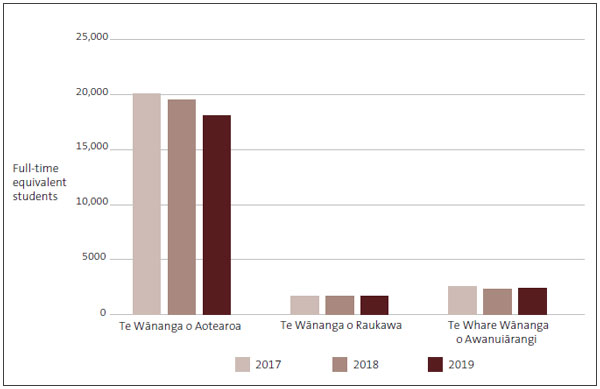Part 6: Wānanga financial results and enrolments
Main financial results
6.1
Te Wānanga o Aotearoa just about broke even in 2019, after incurring an almost $5 million deficit in 2018. It previously achieved surpluses in 2016 ($2.6 million) and 2017 ($3.1 million).
6.2
The wānanga has been reducing costs by changing the programmes it offers. A kaimahi (personnel) restructure in 2018 also reduced its spending by $5.9 million. Its other spending has remained largely stable during the past five years as the wānanga and group continue to focus on controlling operating costs.
6.3
Te Whare Wānanga o Awanuiārangi incurred a deficit of slightly more than $2 million in 2019 (2018: $3 million deficit) and achieved a small surplus in 2017. It is also forecasting a deficit for 2020. However, because it has a high level of cash reserves, it remains in a good position to absorb the 2019 deficit and the forecast deficit for 2020. It has also implemented cost-saving measures and spent $3.8 million less than it budgeted for 2019.
6.4
Te Whare Wānanga o Awanuiārangi continues to make its case to the Government for improved indicators of success of importance to Māori and better alignment of funding rates to reflect the levels of support students might need. It is also evaluating its strategy for organisational success against any potential effects from the creation of Te Pūkenga and its network of subsidiaries.
6.5
Te Wānanga o Raukawa has not incurred a deficit in four years. In 2019, its surplus was $10 million more than in 2018. This was because the Crown partially resolved a Whakatupu Mātauranga claim.32 The partial resolution was paid as a grant and relates to Raukawa’s claim that it had not benefited from the Performance-Based Research Fund since it was established.
6.6
The wānanga reflected the grant in its revenue and operating surplus for 2019. It is continuing work to resolve other aspects of its claim under a relationship agreement it signed with the Crown in 2019.33
6.7
All three wānanga have strong balance sheets, although Te Whare Wānanga o Awanuiārangi’s equity reduced by slightly less than $3 million in 2019. All three wānanga have current ratios of more than 2.
6.8
Te Wānanga o Aotearoa had a strong cash flow from its operations, good equity, and low debt of under $0.5 million. Te Wānanga o Raukawa’s operating cash flow doubled from 2018 to 2019 when comparing like with like.34 Te Whare Wānanga o Awanuiārangi had a negative cash flow from operations in 2019, but it has good equity and no debt.
6.9
Although still uncertain, the immediate effects of Covid-19 on wānanga are less obvious than those for ITPs or universities. The border closure has not affected revenue in 2020 because wānanga do not have many, or any, international EFTS. However, other economic factors related to Covid-19 might affect enrolments at wānanga in 2020 and 2021.
Enrolments
6.10
Usually, only domestic students enrol at a wānanga. The number of international students enrolled at a wānanga has never been high. For example, in 2019, only 15 international EFTS were enrolled at wānanga.
6.11
Figure 9 shows the total enrolments at wānanga from 2017 to 2019. Enrolments at Te Wānanga o Raukawa increased to 1682 in 2019 (2018: 1629). Te Whare Wānanga o Awanuiārangi had 2369 EFTS in 2019, which is 82 more than in 2018.
Figure 9
Total equivalent full-time student enrolments at wānanga, from 2017 to 2019

Source: Data collected from wānanga annual reports.
6.12
The largest wānanga, Te Wānanga o Aotearoa Te Kuratini o Ngā Waka, had more than 18,100 EFTS in 2019, which is just under 1400 fewer than in 2018.
6.13
The wānanga stopped offering some lower-level computer courses from 2019. There was also a significant decrease in 2019 EFTS funded through the Youth Guarantee programme and no international EFTS.
6.14
The decline in EFTS has continued into 2020, and the wānanga is under-delivering against its budget. Although the wānanga will be protected by the funding guarantee for 2020 (see paragraph 3.21), the scale of its under-delivery is significant, at about $25 million.
Conclusion
6.15
There were no indicators of financial stress at wānanga at the end of 2019, although Te Wānanga o Aotearoa is significantly behind on delivery in 2020. All wānanga are watching to see whether the reforms of vocational education will affect their operations.
32: Waitangi Tribunal Claim (WAI 2698) at justice.govt.nz.
33: “Te Wānanga o Raukawa receives one-off $10m grant” (5 December 2019) at rnz.co.nz.
34: This does not include the $10 million partial settlement it received in 2019.

